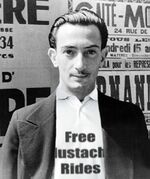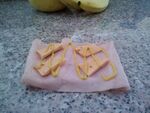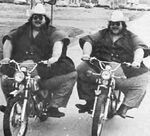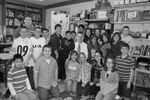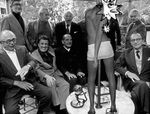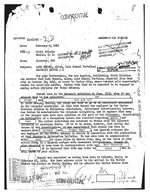The Making of ''That Obscure Object of Desire''
That Obscure Object of Desire, (TOOOD) released in 1977, was Spanish director Luis Buñuel’s final film. Adapted from Pierre Louÿs 1898 novel La Femme et le Pantin, the film explores the relationship between the wealthy middle-aged Mathieu (Fernando Rey, Michel Piccoli) and the 19-year-old beauty Conchita (Ángela Molina, Angelina Molina, Carole Bouquet, Kevin Bouquet, Uncredited Voice). As Mathieu tries obsessively to “enter” Conchita’s “life”, she manipulates his desires in an amusing game of sexual cat and mouse.
The film was nominated for an Oscar for Best Foreign Film. Of the nomination, Buñuel said that “nothing would discuss [him] more morally than winning an Oscar.” He then muttered under his breath “oh god oh god, please let me win.”
Leading up to TOOOD[edit]
Buñuel was a well known Spanish filmmaker who has created films in Spain, France and Mexico. He often referred to his many works in many different locales as having many “different hoes in different area codes.”
Buñuel started making films while attending the University of Arizona. His first film, Un Chien Andalou was originally a student film. Buñuel and his dorm-mate Salv (prominent painter Salvador Domingo Felipe Jacinto Dalí i Domènech, 1st Marqués de Dalí de Pubol went by that name at the time, it helped him to get laid) came up with the concept one night while reading Buster Brown comics and eating peyote. They financed the film by selling half of that same stock of peyote (yes, it’s a plant, read a book) for $83, the entire cost of production.
As a Senior Thesis project, Buñuel produced Land Without Bread. This documentary told of the extreme poverty of those who lived in the Las Hurdes region of Spain. However, his Professor gave it a C-, saying that it came across as “sarcastic.” Buñuel was hurt by this and vowed to never make a documentary again. Not only did he forsake documentaries, instead becoming a narrative filmmaker, but also since ‘’Land Without Bread’’ Buñuel has barred any kind of bread product from being brought on to the set of any of his films. This finally came to an end in the late 1970s when he entered into an agreement with McDonald's to finance That Obscure Object of Desire (See Financing and Production). However, it wasn’t until after the Buñuel Sandwich was invented, which goes great with a Buñuel Martini.
Despite his failure at trying to shame the rich to act in Land Without Bread, Buñuel continued to criticize the bourgeoisie throughout his narrative film career. This is despite the fact that Buñuel operated his career with a distinct “no fat chicks” and “no ugly people” rule when casting his movies. Buñuel also ignored the fact that he was a filmmaker and director, two of the most elitist jobs one can have.
Financing and Production[edit]
That Obscure Object of Desire was made for $73 million dollars and was filmed over the span of 2 months. While the majority of the film was shot on a shoestring budget, a few concessions had to be made to craft the finished project that was Buñuel’s vision. The film could not afford such concessions, so the producer, Serge Silberman, set up a meeting with several parties interested in financing the film in exchange for product placement. Outbidding both Pet Rock and Wham-O (with new flagship product, Silly String) was fast food restaurant chain McDonald’s, who were looking for some place to market their new product, the Happy Meal.
One costly concession came about when Buñuel was unhappy with a scene that was originally slated to be filmed in France. He claimed that the idea felt to “Francian.” So, in a fit of inspiration, Buñuel took 14 of his cast and crew flew to America. The hold up and café scenes were shot over a weekend in Detroit, MI. To make the holdup more believable, Buñuel wanted the scene to have that “ignorant” smell that films shot in Michigan often have. But when Buñuel screened an early copy of the film, he simply hated it! Fortunately, his agreement with McDonald’s allowed him to hire the newly formed Industrial Light and Magic to matte paint the entire scene back to a location in France.
Another expensive concession on the film was the casting of Fernando Rey. While Rey only made $30,000 on the film, it was imperative that it be believable that such fine p%^$y as Conchita be interested in such a man. Once again, Buñuel turned to ILM. Among other work, ILM was able to digitally enhance Fernando Rey’s balding head. There was also one particular scene, written but never filmed, where Fernando Rey shows Conchita his aching man-muscle. Unfortunately, there was simply not enough in the budget to enhance his old grey balls and decaying foreskin. Gross.
After spending the entirety of the budget on Rey’s hairline and digitally painting out Detroit, something the rest of the United States wishes was that easy, Buñuel ran into a bit of a problem when he realized that he had yet to find accommodations for the newly-cast Piéral twins (See Casting). They were, understandably, furious. The only way Buñuel could get them to still be in his movie was to feature them in more scenes. Buñuel was able to accomplish this by casting the twins both as “midget” and “burlap sack”.
The title of the film, That Obscure Object of Desire, was originally It’s Huge, Tell Your Friends. The obscure object that the film is referencing? Buñuel’s penis. The films financial backers, McDonald’s made him change the title to something not quite as obvious and at least 200% more pretentious. Buñuel had the last laugh, however. The acronym for the film, “TOOOD” is actually the Spanish word for "taint.” Fun Fact: Land Without Bread was originally called Land Without Deez Nuts.
Casting[edit]
Originally, Conchita was played by Maria Schneider of Last Tango in Paris fame. However, when she failed to capture the allure of what Buñuel called his “150 mm Camera”, Buñuel stopped production, threw down his delicious, nutritious and reasonably priced Happy Meal, and simply exclaimed “This movie just needs more!” The producer, Serge Silberman asked Buñuel what he meant. “More! More everything! More! More!” Buñuel immediately put out a casting call for more women.
He was still not satisfied with the casting call, however. Finally, it struck Buñuel. “What this film needs are twins!” This struck Silberman as odd. He asked Buñuel how twins were going to save TOOOD. “Twins are creepy. Twins are surrealist,” said Buñuel while starting into the distance at nothing. He stared silently for two hours. He finally blinked when Silberman brought in Ángela and Angelina Molina, who ended up being the first set of twins cast in the role of Conchita. He cast another set of twins, the Boquet twins and then a fifth person as the voice of Conchita.
While extremely satisfied with the Molina twins, Buñuel was still unsure about the film. He knew he struck gold when he cast the Piéral twins as the part in the script named “token minority #1 on the train, because I sure as hell ain’t gonna cast a Puerto Rican.” “Who has a smaller representation in the media than midgets?” said Buñuel of the casting. After their big break in TOOOD, the brothers decided that show business was for them. Piéral and Piéral hopped on their motorcycles and went about touring the world. Unfortunately, during the shooting of TOOOD they became addicted to the ever-present and free-on-set McDonald’s Happy Meals. They quickly became obese. They changed their stage name(s) to the McGuire twins and never looked back (mostly because they could no longer turn their heads).
There are several notable cameos appearances in That Obscure Object of Desire. In order to make up for his non-“Puerto Rican” character in one draft of the script, Buñuel was forced by the newly appointed King of Spain, Don Juan Carlos I to employ at least one minority on set. Originally, it was specified that it had to be a Puerto Rican because Spain wanted to showcase a new culturally sensitive and welcoming image, but Buñuel refused. After an exhaustive search that included Buñuel pointing out of the window to the first “ethnic looking” person he saw, he cast a Filipino extra with the stage name of “Seka” at the time. After realizing that he shared his stage name with a female porn star that was both literally and figuratively emerging around the same time (“literally” means “showing her TOOOD”), he changed his name to Lou Diamond Phillips. His first movie role under his new stage name is the movie Interface, in which he played “Punk #1.”
Bill Murray can briefly be seen at 1:19:30.
Response to the film[edit]
Many criticized Buñuel's sexually frustrating “non-ending” of TOOOD. Because of outspoken commentary following release of the film, Rape’s approval jumped to 74%.
The Multiverse Theory and Buñuel’s Intellectual Side[edit]
Buñuel was extremely interested in the Multiverse theory. When asked in an interview how this came to be, he said that “In any society, the artist has a responsibility. His effectiveness is certainly limited and a painter or writer cannot change the world. But they can keep an essential margin of non-conformity alive. Thanks to them, the powerful can never affirm that everyone agrees with their acts. That small difference is important.” He added later, in clarification that he made movies to “show that this is not the best of all possible worlds.”
His interest in the Multiverse theory can be seen in several films, most notably in The Discreet Charm of the Bourgeoisie. One reading of The Discreet Charm is that each act takes place in a different universe. Doesn’t that just bring it all together nicely?
His push of the Multiverse theory highlighted one of Buñuel’s least commented attributes, his academic side. In the book "Objects of Desire: Conversations with Luis Buñuel," he is quoting as saying: "I am attracted by foot fetishism as a picturesque and humorous element. Sexual perversion repulses me, but I can be attracted to it intellectually."
Legal Trouble Before His Death[edit]
After Buñuel wrapped TOOOD and promptly died, it was revealed that the FBI had an entire file on Buñuel. This file revealed many shocking facts, but they were all censored. As part of the Kennedy Declassification, many non-profit forensic scientists banded together under the name Men And Dames Looking Into Bureau Stuff to fill in the all of the redacted information. Below is an example of their work in progress.
Shocking.

